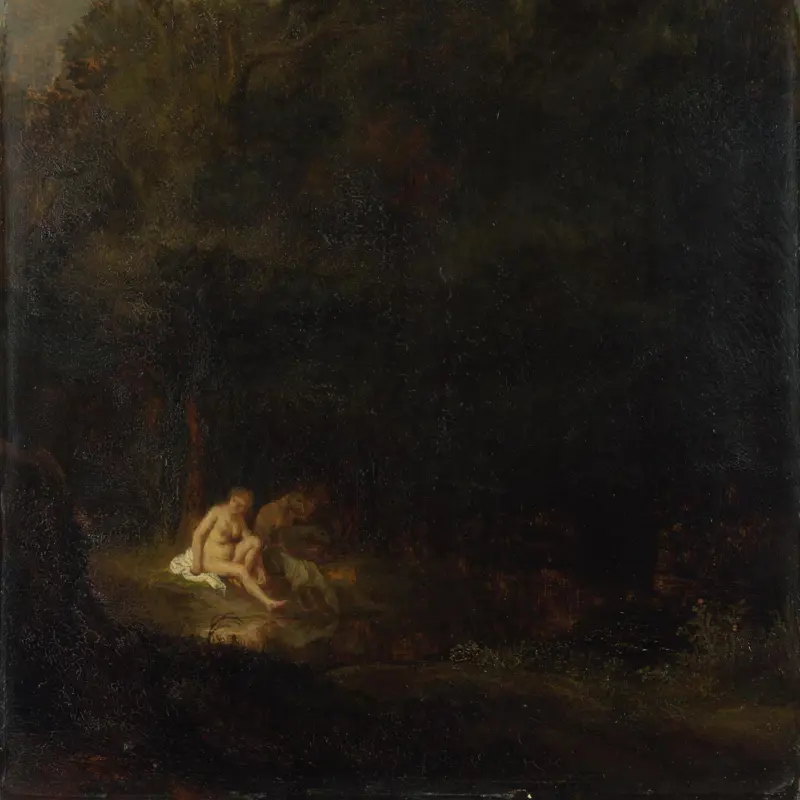Rembrandt, 'Portrait of Aechje Claesdr.', 1634
About the work
Overview
The optical illusion created by this painting is a powerful one. Rembrandt has used contrasts between light and dark – for example, the blacks and whites of the sitter’s clothes, the highlights on her nose and the heavy shadow under her chin – to create a highly convincing three-dimensional effect. The old lady’s head seems to project forward out of the picture.
It isn’t only light effects that make this portrait seem so lifelike. Rembrandt has evoked the old lady’s blotched, blemished and sagging skin using different textures and thicknesses of paint. The furrows and shadows, the wrinkles and pudginess make her face seem almost tangible. He did this with a lively brush, applying the paint fluidly with short and curving strokes as well as dabs and stipples.
Long thought to be a portrait of Rembrandt’s grandmother, the sitter has now been identified as Aechje Claesdr. (1551–about 1635), the widow of the Rotterdam brewer Jan Pesser, who died in 1619.
Key facts
Details
- Full title
- Portrait of Aechje Claesdr.
- Artist
- Rembrandt
- Artist dates
- 1606 - 1669
- Date made
- 1634
- Medium and support
- Oil on wood (probably oak)
- Dimensions
- 71.1 × 55.9 cm
- Inscription summary
- Signed; Dated and inscribed
- Acquisition credit
- Bought, 1867
- Inventory number
- NG775
- Location
- Room 22
- Collection
- Main Collection
- Previous owners
- Frame
- 18th-century French Frame
Provenance
Additional information
Text extracted from the ‘Provenance’ section of the catalogue entry in Neil MacLaren, revised and expanded by Christopher Brown, ‘National Gallery Catalogues: The Dutch School: 1600–1900’, London 1991; for further information, see the full catalogue entry.
Exhibition history
-
2019Young RembrandtStedelijk Museum De Lakenhal1 November 2019 - 9 February 2020The Ashmolean Museum of Art and Archaeology27 February 2020 - 1 November 2020
Bibliography
-
1829
J. Smith, A Catalogue Raisonné of the Works of the Most Eminent Dutch, Flemish, and French Painters: In Which is Included a Short Biographical Notice of the Artists, with a Copious Description of Their Principal Pictures […], 9 vols, London 1829-1842
-
1854G.F. Waagen, Treasures of Art in Great Britain: Being and Account of the Chief Collections of Paintings, Drawings, Sculptures, Illuminated Mss. […], vol. 2, trans. E. Eastlake, London 1854
-
1877C. Vosmaer, Rembrandt: Sa vie et ses oeuvres, La Haye 1877
-
1893É. Michel, Rembrandt, sa vie, son oeuvre et son temps, Paris 1893
-
1897W. von Bode and C. Hofstede de Groot, The Complete Work of Rembrandt, 8 vols, Paris 1897
-
1907C. Hofstede de Groot, Catalogue Raisonné of the Works of the Most Eminent Dutch Painters of the Seventeenth Century, 10 vols, London 1907
-
1907C. Hofstede de Groot, Catalogue Raisonné of the Works of the Most Eminent Dutch Painters of the Seventeenth Century, 10 vols, London 1907
-
1932A.P. Laurie, 'A Doubtful Rembrandt', Apollo, 1932, pp. 176-80
-
1960Maclaren, Neil, National Gallery Catalogues: The Dutch School, 2 vols, London 1960
-
1980J. Mills and R. White, 'Analyses of Paint Media', National Gallery Technical Bulletin, IV, 1980, pp. 65-7
-
1985G. Schwartz, Rembrandt: His Life, His Paintings, Harmondsworth 1985
-
1988D. Bomford et al., Rembrandt (exh. cat. The National Gallery, 12 October 1988 - 17 January 1989), London 1988
-
1989J. Mills and R. White, 'Paint Media Analyses', National Gallery Technical Bulletin, XIII, 1989, pp. 69-71
-
1991Maclaren, Neil, revised by Christopher Brown, National Gallery Catalogues: The Dutch School, 1600-1900, 2nd edn (revised and expanded), 2 vols, London 1991
-
1991C. Grimm, Rembrandt selbst: Eine Neubewertung seiner Porträtkunst, Stuttgart 1991
-
1991W. Froentjes, H.J.J. Hardy and R. ter Kuile-Haller, 'Een schriftkundig onderzoek van Rembrandt signaturen.', Oud Holland, CV, 1991, pp. 185-204
-
1991C. Brown, J. Kelch and P.J.J. van Thiel, Rembrandt: The Master and his Workshop (exh. cat. Gemäldegalerie SMPK at the Altes Museum, 12 September - 10 November 1991; Rijksmuseum, 4 December - 1 March 1992; The National Gallery, London, 25 March - 24 May 1992), New Haven 1991
-
1992S.A.C. Dudok van Heel, 'Enkele observaties bij het portet van een 83-jarige dame uit 1634 door Rembrandt', Maandblad Amstelodamum, LXXIX, 1992, pp. 6-15
-
1993C. Tümpel, Rembrandt: All Paintings in Colour, Antwerp 1993
-
1994S.A.C. Dudok van Heel, 'De remonstrantse wereld van Rembrandts opdrachtgever Abraham Anthoniszn de Recht', Bulletin van het Rijksmuseum, IV, 1994, pp. 334-46
-
1999S. Schama, Rembrandt's Eyes, New York 1999
-
2000C. Wright, Rembrandt, Paris 2000
-
2000S.A.C. Dudok van Heel, 'Rembrandt van Rijn (Leiden 1606-Amsterdam 1669): De schilder, zijn leven, zijn vrouw, de min en het dienstmeisje', Kroniek van het Rembrandthuis, 1-2, 2000, pp. 2-40
-
2001
C. Baker and T. Henry, The National Gallery: Complete Illustrated Catalogue, London 2001
-
2001E. van de Wetering and B. Schnackenburg, The Mystery of the Young Rembrandt, (exh. cat. Gemäldegalerie Alte Meister, 3 November 2001 - 27 Jnaury 2002), Wolfrathausen 2001
-
2006S.A.C. (Bas) Dudok van Heel, De jonge Rembrandt onder tijdgenoten: Godsdienst en schilderkunst in Leiden en Amsterdam, Nijmegen 2006
-
2007R. Ekkart and Q. Buvelot, Dutch Portraits: The Age of Rembrandt and Frans Hals (exh. cat. The National Gallery, 27 June - 16 September 2007; Mauritshuis, 13 October 2007 - 13 January 2008), London 2007
About this record
If you know more about this work or have spotted an error, please contact us. Please note that exhibition histories are listed from 2009 onwards. Bibliographies may not be complete; more comprehensive information is available in the National Gallery Library.



























